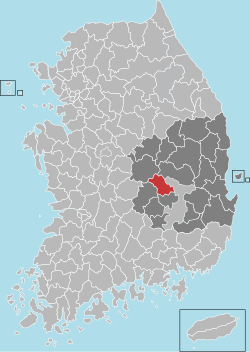Gumi
구미시 | |
|---|---|
| Korean transcription(s) | |
| • Hangul | 구미시 |
| • Hanja | 龜尾市 |
| • Revised Romanization | Gumi-si |
| • McCune–Reischauer | Kumi-si |
 Gumi city hall | |
 Location in South Korea | |
| Country | |
| Region | Yeongnam |
| Administrative divisions | 3 eup, 5 myeon, 17 dong |
| Government | |
| • mayor | Jang Ho Kim (김장호) |
| Area | |
• Total | 616.25 km2 (237.94 sq mi) |
| Population (September 2024[1]) | |
• Total | 404,691 |
| • Density | 552.5/km2 (1,431/sq mi) |
| • Dialect | Gyeongsang |
| Demonym | Gumite |
| Time zone | UTC+9 (Korea Standard Time) |
| Area code | +82-54 |
Gumi (Korean: 구미; Korean pronunciation: [ku.mi]) is the second largest and most densely populated city in North Gyeongsang Province, South Korea. It is located on the Nakdong River, halfway between Daegu and Gimcheon, also lies on the Gyeongbu Expressway and Gyeongbu Line railway which are the principal traffic routes of the country.
The city is an industrial center of the country with many companies, including Samsung Electronics, LG Electronics, LG Display, having a manufacturing presence and R&D Centres there.
The primary industries are electronics and IT Manufacturing such as Smartphone, Tablet computer, 5G and 6G Networking Equipment, Semiconductors, OLED and other Displays, Carbonated fibres, rubber, plastic and metal products. In Gumi, 1,772 companies employ over 80,000 workers.[2] It is the largest scale in Korea. In 2009, the city exported the largest amount in the country and accounted for 96.9% of trade surplus of Korea in 2000 to 2009.[3]
The birthplace of South Korean president Park Chung Hee is in the city.
- ^ "Population statistics". Korea Ministry of the Interior and Safety. 2024.
- ^ 구미시청 & 구미소개. Archived from the original on 2009-12-20. Retrieved 2010-03-22.
- ^ 국내 무역 흑자액 97%는 구미공단 몫.
